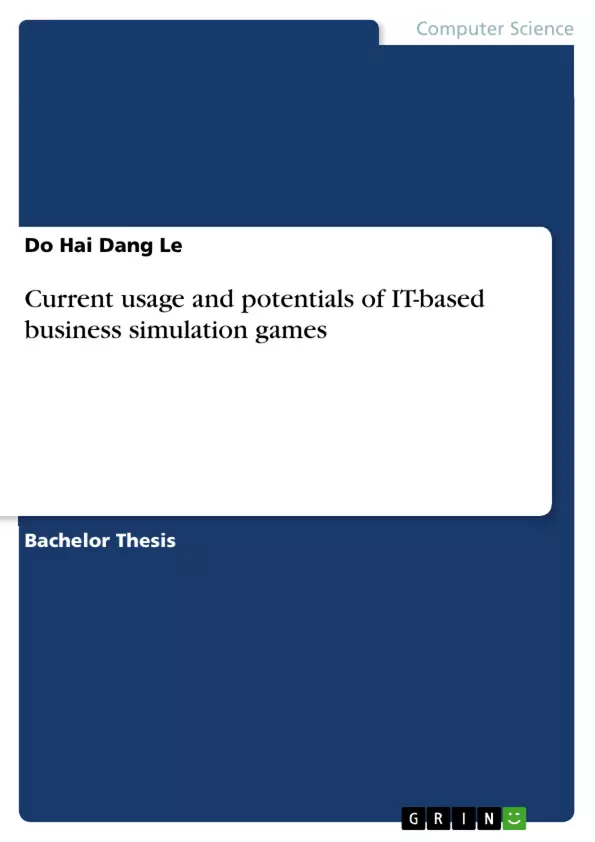By firstly reviewing current literature on business simulation gaming and IT-based BSGs, this thesis will provide an overview on the usage of IT-based BSGs at present. After that, several selected potential concepts and technologies will be studied to discuss how they can affect the future of IT-based BSGs.
In the first chapter, before going to any of the two main questions, basic knowledge on IT-based BSGs will be provided. Additionally, the chapter also introduces their general features, the standard process of deploying them in practice and the standard architecture of current IT-based BSGs. After that, the following two chapters will answer the questions correspondingly. Chapter 3 will focus on the current usage of IT-based BSGs. Each of the application fields and the concrete usage purposes in each field will be presented. In addition, actual and relevant examples will also be presented to demonstrate them. Chapter 4 will proceed with the second question, on the potentials of specific concepts and technologies for the future development of IT-based BSGs. The chapter will be divided into two parts, with the first concentrating on the concepts and the second on the technologies. The last chapter, the discussion, will summarize and discuss the findings in the previous chapters
Inhaltsverzeichnis (Table of Contents)
- Introduction
- Basic knowledge
- IT-based business simulation games
- General features of IT-based business simulation games
- Content
- Immersion
- Interactivity
- Communication
- Standard process of using IT-based business simulation games
- Standard architecture of IT-based business simulation games
- Current usage of IT-based business simulation games
- IT-based business simulation games in education and training
- Teaching basic knowledge
- Teaching cross-functional understanding within the business
- Training technical skills
- Training social skills
- IT-based business simulation games in experimental research
- Economic research
- Organizational and leadership study
- Psychological research
- IT-based business simulation games in business practice
- Forecasting in strategic planning
- Employee assessment and recruitment marketing
- IT-based business simulation games in education and training
- Potentials of IT-based business simulation games
- Potentials concepts for IT-based business simulation games
- The serious game concept
- Introduction to the serious game concept
- Serious game and IT-based business simulation games
- Usage, benefits and issues
- The role-playing concept
- Introduction to the role-playing concept
- Role-playing and IT-based business simulation games
- Usage, benefits and issues
- The serious game concept
- Potential technologies for IT-based business simulation games
- The real-time data technology
- Introduction to the real-time data technology
- Real-time data and IT-based business simulation games
- Usage, benefits and issues
- The dialog system technology
- Introduction to the dialog system technology
- Dialog systems and IT-based business simulation games
- Usage, benefits and issues
- The real-time data technology
- Potentials concepts for IT-based business simulation games
- Discussion
Zielsetzung und Themenschwerpunkte (Objectives and Key Themes)
This thesis explores the current usage and future potential of IT-based business simulation games. The author aims to analyze the existing applications of these games in education, research, and business practice, while identifying and examining key concepts and technologies that can further enhance their capabilities and impact.
- The role of IT-based business simulation games in education and training
- The application of these games in experimental research across various fields
- The practical uses of IT-based business simulation games in business settings
- Emerging concepts and technologies that can enhance the effectiveness of these games
- The benefits and challenges associated with the adoption of IT-based business simulation games
Zusammenfassung der Kapitel (Chapter Summaries)
The introduction provides a brief overview of the thesis's scope and purpose. Chapter 2 focuses on the foundational knowledge of IT-based business simulation games, covering their general features, standard processes, and typical architecture.
Chapter 3 delves into the current usage of these games across various sectors. It examines their application in education and training, experimental research (including economic, organizational, and psychological studies), and business practice (with a focus on strategic planning and human resource management).
Chapter 4 explores the potential of IT-based business simulation games by analyzing key concepts such as serious games and role-playing, along with promising technologies like real-time data systems and dialog systems. This chapter examines the potential benefits, drawbacks, and implications of integrating these concepts and technologies into existing games.
The discussion chapter will delve into the findings of the analysis, offering insights into the future development and application of IT-based business simulation games.
Schlüsselwörter (Keywords)
The key areas of focus in this thesis include: IT-based business simulation games, education and training, experimental research, business practice, serious games, role-playing, real-time data, dialog systems, and potential benefits and challenges.
- Quote paper
- Do Hai Dang Le (Author), 2012, Current usage and potentials of IT-based business simulation games, Munich, GRIN Verlag, https://www.grin.com/document/264697



